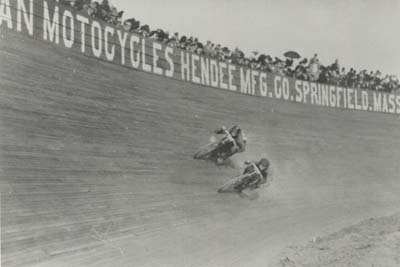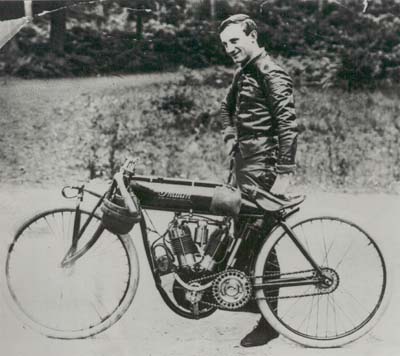by Daniel K. Statnekov |
| ©1998 - 2006 Daniel K. Statnekov |
|
As board track racing was becoming the most popular motorcycle sport in
the United States, it was a natural consequence that the two partners
would join forces with the prominent builder of wooden tracks, "Jack"
Prince, to construct a "home-town" motordrome.
With an ownership in Springfield's new 1/3-mile pine-board "drome," Hendee
and Hedstrom would not only have control of their local arena, but they
would also have a "test-track" for their factory team. At least
this is what they thought in the summer of 1909, on the eve of the opening
of Springfield Stadium.
But a race isn't a race without competition, and in each one of the dozens of fledgling motorcycle manufacturers that had "sprung up" across the country, there were men who dreamed of success on the race track, a victory that would lead them to success in the marketplace. One such man was Ignaz Schwinn, immigrant, self-made millionaire kingpin of the bicycle manufacturers, who within two years would challenge Indian's supremacy. There were other men who had dreams of winning races, young men who could hear the roar of the crowd in their imagination, and envision the paycheck that they would earn for their exploits. It was not money or glory alone, however, that had captivated these youngsters. Each boy had somehow "caught the fever" to race a motorized steed, a passion that was unimaginable to the generation that had preceded them. One such boy was "Jake" DeRosier who was born in Quebec, Canada in 1880. When Jake was a child his family moved to Massachusetts where velodrome bicycle racing was very popular. At seventeen, DeRosier took up the sport, and in 1898 he got a ride on one of the French pacing machines. The teenager was completely taken with the motor-powered tandem, and shortly thereafter he obtained a full-time position as a rider of the new device. This gave him experience with the gasoline engine and in 1901 he was hired by Oscar Hedstrom. Although DeRosier only stayed with Indian for a few months, he continued his relationship with the two founders of the Springfield company. Both of the partners continued to encourage Jake's participation in the sport, tutoring him in techniques that they had learned during their own racing careers. Over the next few years, DeRosier was successful, capitalizing on his own natural ability and the lessons taught to him by his mentors.
In July of 1908, on a "borrowed" Indian prototype, DeRosier set a
quarter-mile record at the Paterson, New Jersey velodrome. Jake's
average speed was 68.2 mph and he won the three-mile race on the same
day in a shade over 3 minutes. As a result of this performance,
the 28 year-old cyclist was added to the official Indian team.
While riding for Indian DeRosier gained fame quickly, having a talent
for close drafting and an eye for the fastest line around the track.
In 1909, Jack Prince brought the Indian star to Los Angeles to help promote his new Coliseum motordrome. DeRosier set records at Prince's wood-planked drome, and proved himself to the west coast crowd by defeating California's top rider, Paul "Dare Devil" Derkum. Continuing in 1910 and 1911, DeRosier won literally hundreds of races and continued to set records that established him as "the man to beat" in American motorcycle racing. From Philadelphia to Los Angeles, huge crowds cheered Indian's colorful star rider, who wore black theatrical tights and running shoes as his racing attire. Although historians differ as to the reason, when he returned from an English race tour in the late summer of 1911, Jake DeRosier was fired by George Hendee. One story is that the Indian chief executive was very disappointed with DeRosier's performance at the Isle of Man, and the men's subsequent argument resulted in his dismissal. Whatever the reason, DeRosier immediately left for Chicago where he was hired by Ignaz Schwinn to ride for Excelsior. The Chicago-built machines were never regarded very seriously as racing equipment, but in 1911 that changed. Perhaps it was Ignaz Schwinn's good fortune (for he had just purchased the company), or due to the efforts of unheralded Excelsior engineers, but since the beginning of the year, the company's V-twin, pocket-valve motor was nearly unbeatable. In August, at Chicago's Riverview motordrome, an Excelsior set a record for the mile, burning up the boards at an average speed of 88.9 mph. As it turned out, Jake arrived just in time to take advantage of the fast, new Excelsior motors. By September, the former Indian star was back in the "groove," not only winning the feature event at Riverview, but also setting an unofficial world record for the kilometer, at a speed of 94 mph. With DeRosier setting the pace, Ignaz Schwinn's motorcycle company quickly moved into the limelight. Within the first year of his buying the company, the Excelsior entry was being acclaimed as the fastest bike on the boards. |
|
|
|
|
|
Webmaster: daniels@statnekov.com |
Page installed: Nov. 15, 1996 Page revised: June 28, 2003 |

